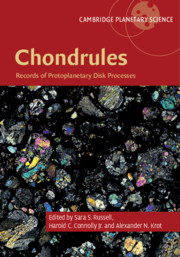Book contents
- Chondrules
- Cambridge Planetary Science
- Chondrules
- Copyright page
- Contents
- Contributors
- 1 Introduction
- Part I Observations of Chondrules
- 2 Multiple Mechanisms of Transient Heating Events in the Protoplanetary Disk
- 3 Thermal Histories of Chondrules
- 4 Composition of Chondrules and Matrix and Their Complementary Relationship in Chondrites
- 5 The Chondritic Assemblage
- 6 Vapor–Melt Exchange
- 7 Chondrules in Enstatite Chondrites
- 8 Oxygen Isotope Characteristics of Chondrules from Recent Studies by Secondary Ion Mass Spectrometry
- 9 26Al–26Mg Systematics of Chondrules
- 10 Tungsten Isotopes and the Origin of Chondrules and Chondrites
- 11 The Absolute Pb–Pb Isotope Ages of Chondrules
- 12 Records of Magnetic Fields in the Chondrule Formation Environment
- Part II Possible Chondrule-Forming Mechanisms
- Index
- Plate Section (PDF Only)
- References
10 - Tungsten Isotopes and the Origin of Chondrules and Chondrites
from Part I - Observations of Chondrules
Published online by Cambridge University Press: 30 June 2018
- Chondrules
- Cambridge Planetary Science
- Chondrules
- Copyright page
- Contents
- Contributors
- 1 Introduction
- Part I Observations of Chondrules
- 2 Multiple Mechanisms of Transient Heating Events in the Protoplanetary Disk
- 3 Thermal Histories of Chondrules
- 4 Composition of Chondrules and Matrix and Their Complementary Relationship in Chondrites
- 5 The Chondritic Assemblage
- 6 Vapor–Melt Exchange
- 7 Chondrules in Enstatite Chondrites
- 8 Oxygen Isotope Characteristics of Chondrules from Recent Studies by Secondary Ion Mass Spectrometry
- 9 26Al–26Mg Systematics of Chondrules
- 10 Tungsten Isotopes and the Origin of Chondrules and Chondrites
- 11 The Absolute Pb–Pb Isotope Ages of Chondrules
- 12 Records of Magnetic Fields in the Chondrule Formation Environment
- Part II Possible Chondrule-Forming Mechanisms
- Index
- Plate Section (PDF Only)
- References
Summary
Chondrules and matrix from carbonaceous chondrites exhibit complementary nucleosynthetic W isotope anomalies that result from the depletion of a metallic s-process carrier in the chondrules, and the enrichment of this carrier in the matrix. The complementarity is difficult to reconcile with an origin of chondrules in protoplanetary impacts and also with models in which chondrules and matrix formed independently of each other in distinct regions of the disk. Instead, the complementarity indicates that chondrules formed by localized melting of dust aggregates in the solar nebula. The Hf–W ages for metal-silicate fractionation in CV and CR chondrites are 2.2 ± 0.8 Ma and 3.6 ± 0.6 Ma after formation of Ca-Al-rich inclusions, and are indistinguishable from Al–Mg ages for CV and CR chondrules. The good agreement between these ages strongly suggests that 26Al was homogeneously distributed in the solar protoplanetary disk and that therefore Al–Mg ages are chronologically meaningful. The concordant Al–Mg and Hf–W ages reveal that chondrule formation (as dated by Al–Mg) was associated with metal-silicate fractionation (as dated by Hf–W), both within a given chondrite but also among the different subgroups of ordinary chondrites. These age data indicate that chondrules from a given chondrite group formed in a narrow time interval of <1 Ma, and that chondrule formation and chondrite accretion were closely linked in time and space. The rapid accretion of chondrules into a chondrite parent body is consistent with the isotopic complementarity, which requires that neither chondrules nor matrix were lost prior to chondrite accretion. Combined, these observations suggest that chondrule formation was an important step in the accretion of planetesimals.
- Type
- Chapter
- Information
- ChondrulesRecords of Protoplanetary Disk Processes, pp. 276 - 299Publisher: Cambridge University PressPrint publication year: 2018
References
- 7
- Cited by

